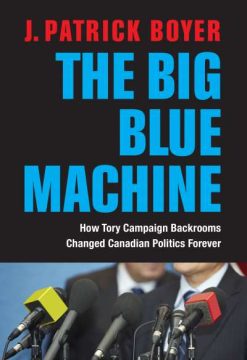If focus groups were infallible every candidate would be a winner, every movie would be a blockbuster, every toothpaste would be recommended by 9 out of 10 dentists. Dilbert creator Scott Adams described focus groupers as people thrilled that somebody asked their opinion and gave them a free lunch at the same time. “There are actually some people who admitted in focus groups that they would sometimes taste soap,” he wrote.
Yet the mythology of focus group infallibility persists due in no small part to the claims of pollsters paid to conduct them, which brings us to The Big Blue Machine, J. Patrick Boyer’s account of “how Tory campaign backrooms changed Canadian politics forever.” Boyer is a former two-term Progressive Conservative MP for Etobicoke-Lakeshore. He is also an honest correspondent and skillful writer. The subtext to Big Blue Machine is failure. Boyer admits as much.
“Renown was larger than the reality,” he writes. Political fixers, ad men, pollsters and marketers “understood how it advanced their purposes to be seen, not as fallible human beings, but as men operating a superhuman ‘machine.’” Big Blue Machine documents the rise and fall of Dalton Camp, the ultimate Tory fixer who aspired to become prime minister or at least control one, and instead spent his twilight years cranking out columns for the Toronto Star. “He had not become the hero he’d envisaged himself to be,” Boyer notes.
Folk tales of fixers’ infallibility persist. Practitioners delight in he-man vernacular, describing themselves as “war-roomers” and “ass-kickers.” The effect is occasionally pathetic. Boyer recounts that Camp became an avid reader of “ground-breaking books from the United States on psychology, advertising, mass communication and techniques for altering patterns of human behaviour.” Presumably none of Camp’s rivals owned a library card.
The result: When Toronto lawyer Allan Lawrence ran for the leadership of the Ontario Tory party in 1971 “the Camp agency designed a visually bold logo for the Lawrence campaign consisting of three basic forms (a circle, a square and a triangle) in three solid basic colours (red, yellow, blue) that was unmistakable, bold and simple.” Lawrence lost.
In Bob Stanfield’s 1972 national campaign, managers hired a six-piece band called Jalopy with a lead accordion player. “Integrating Jalopy into the PC campaigns changed the way entertainment fused with politics, enlivened crowds, made everyone more receptive, and created a better environment for the leader,” Boyer enthuses. In fact campaigners had used warm-up bands since the era of torchlight parades. Stanfield lost.
Ultimately Boyer strikes a haunting chord. Profiling Dalton Camp in his final years, he writes: “Camp came of age in an era where boys modelled themselves on heroes found in books and on movie screens, characters who, through creative editing, were more luminous than anyone could ever be in real life. Forced by his father’s death to return from the United States, one of the teen’s disappointments was to find Canada a land without heroes. ‘In the United States,’ he recalled with longing, ‘we had new ones all the time, men like Charles Lindbergh.’”
“Winston Churchill became a lifelong hero to Dalton, but in Canada nobody came close to his exceptional attributes,” Boyer notes. “Over time, disappointment blunted Camp’s impulse to look for greatness in others.”
By Tom Korski
The Big Blue Machine: How Tory Campaign Backrooms Changed Canadian Politics Forever, by J. Patrick Boyer; Dundurn Press; 416 pages; ISBN 9781-4597-24495; $35









